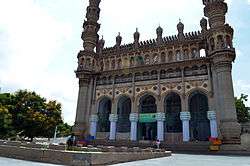Toli Masjid
Toli Masjid (1671 AD), also known as Damri Masjid, is a mosque in Karwan, Hyderabad, India. It is 2 km from the Golconda fort on the way to Charminar. Built by Mir Musa Khan Mahaldar during the region of Abdullah Qutb Shah in (1082 AH).[1]:66 This mosque is INTACH awarded and a declared heritage site by Archaeological Survey of India.[2] On scale of architecture Toli Mosque ranks next after Mecca Masjid, Hyderabad, India.[3]
History
Built by Mir Musa Khan Mahaldar in 1671 AD during the rule of Sultan Abdullah Qutub Shah, it is one of the finest examples of Qutub Shahi architecture. He used architect Mecca Masjid of Hyderabad and royal architect of Sultan Abdullah Qutub Shah.[3]

There is a chapter in the royal records called the "Gulzar-e-Asafia." It mentions that when the royal architect was building Mecca Masjid, he was given one damri/damdi (coin) out of every rupee spent on it. The sum of money thus collected was used by Musa Khan to construct the Toli Masjid. Hence, this masjid is also called Damri Masjid.[4]
Architecture
The mosque is built on a raised platform with a high plinth, divided into two halls, the outer one having five-arched openings, among five outer arches the central arch is slightly wider and more ornate. Two minarets of 20 metres each flank the edifice. The parapets on top comprise a series of miniature arches with perforated screens of different designs. There are five beautiful arches each with lotus medallions in the spandrels. The central arch is a bit wider and more ornate than the remaining four.[1]:66–67
The inscription in the prayer hall reveals that Musa Khan (who played an important role in the accession of the last Qutb Shahi Sultan, Abul Hasan Qutb Shah to the throne of Golconda) built the mosque. The Musa Burj (bastion) of the Golconda fort is also his work.[1]:66–67
The upper half of this mosque is the most beautifully decorated. The parapet consists of a series of arched jali screens, each of a different pattern. Above this runs a row of tiny notches punctuated by six finials. The elaborately decorated minarets have three receding tiers of octagonal galleries, the central one raised on a series of deeply recessed, carved moldings and petals. The minaret shaft is covered with rounded patterns. This composition is adorned by a circular dome and a brass finial.[1]:66–67[5][6]
Deterioration
According to The Hindu, the land around the Toli Masjid had been encroached by the local residents under political influence,[7] and due to pollution and lack of maintenance the mosque minarets are losing its carved beauty.[8]
References
| Wikimedia Commons has media related to Toli Masjid. |
- 1 2 3 4 Bilgrami, Syed Ali Asgar (1927). Landmarks of the Deccan. Asian Educational Services. ISBN 81-206-0543-8.
- ↑ INTACH
- 1 2 India: past & present, 2003, ISBN 81-7648-455-5, by Prakash Chander, Page-148
- ↑ Toli Masjid in Hyderabad India
- ↑ "How protected is our heritage?". timesofindia.indiatimes.com. 12 September 2011. Retrieved 12 September 2011.
- ↑ Toli Masjid « Blog Archive « Hyderabad
- ↑ "'Toli Masjid land encroached'". The Hindu. Chennai, India. 23 September 2008.
- ↑ Indian Ecological Society